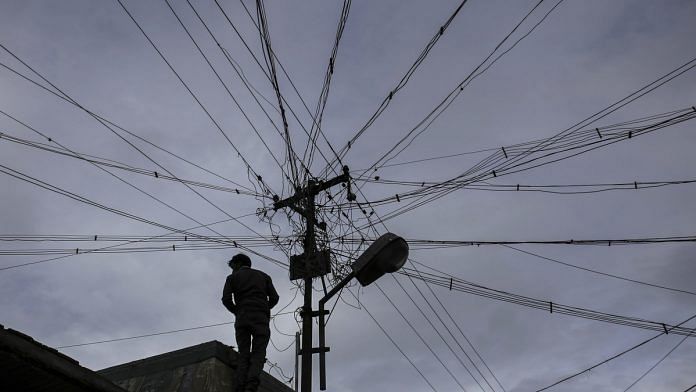The power sector’s contribution to the deterioration in the financial health of Indian states is relatively well-documented. A large share of a state’s total subsidies is spent on providing free electricity. For instance, 97 per cent of Rajasthan’s and 80 per cent of Punjab’s and Bihar’s total subsidy expenditure went toward electricity in 2020-21. But two other important dimensions are often overlooked in the context of state finances.
First, the analysis of state government finances should include the “full debt” of the state, not just the debt reflected in its budget documents. This not only provides a more accurate picture of the debt-to-GDP ratio, but also helps determine the correct value of the potential interest payments that the state may have to make in the coming years.
Second, the dynamics between the interest rate and GDP growth rate cannot be taken for granted. It is essential to understand the vulnerabilities of the state’s fiscal strategy to changes in these macroeconomic variables.
Our new working paper, ‘The electricity chokepoint in Tamil Nadu public finance’, elaborates on these aspects in the context of the state’s financial dynamics.
Also Read: Why surge pricing can spark a brighter future for solar power
‘Corrected’ debt–to–GDP ratios
A standard metric in public finance is the debt-to-GDP ratio, which represents the ratio of a country or state’s debt to its gross domestic product. As the definition suggests, it is an indicator of a state’s ability to repay its debt. The larger the debt-to-GDP ratio, the greater the burden on the state.
Typically, we rely on state government budget documents for debt numbers. However, these understate the debt for two reasons. The first is off-budget debt, which is owed by the state but isn’t reflected in its budget. For all practical purposes, the repayment of this “hidden” debt is the responsibility of the state.
The second is “implicit debt”. This debt isn’t technically owned by the government, but will eventually become its responsibility. This debt is not hidden, but it is generally not considered part of the state government’s official burden.
Taking Tamil Nadu as an example, one could argue that the debt of the two power sector utilities—Tamil Nadu Transmission Corporation (TANTRANSCO) and Tamil Nadu Generation and Distribution Corporation Limited (TANGEDCO)—will likely become the state government’s responsibility. If these two entities are unable to repay their debt, then the state government will have to step in, even though both are distinct from the government.
According to the revised estimates for FY 2023, Tamil Nadu’s debt-to-GDP ratio was 31.56. However, when the outstanding long-term borrowings of the two utilities—approximately Rs 2 lakh crore—are added to the state’s debt, the debt-to-GDP ratio shoots up to 39.7. This is an increase of almost 8 percentage points, and has a material impact on the fiscal sustainability of the state. So, how high can a debt-to-GDP ratio be? The Tamil Nadu Fiscal Responsibility Act 2003 set a target of 25 per cent for 2015, after which the debt-to-GDP was intended to decline. But even without the addition of the power sector debt, Tamil Nadu has crossed this threshold. Other states are likely to be in similar positions.
Also Read: Govts invoking crisis clause in Electricity Act hurts private players. Start storing instead
The importance of ‘r’ and ‘g’
In the years ahead, two factors will shape whether a state’s borrowing becomes unsustainable or not. These are the interest rate (r) at which the government borrows, and the rate at which the state GDP grows (g).
If the financial market lends to the state at low interest rates, and the GDP growth rate continues to be high, the state could continue at this level of borrowing. The bond market in India currently lends to state governments at about 7-8 per cent. It does not discriminate between fiscally responsible and irresponsible states, probably owing to an implicit state guarantee. Power sector utilities also seem to continue to get loans from the Power Finance Corporation (PFC) and the Rural Electrification Corporation Limited (REC). Under current conditions, for most states in India, we see that r < g. In Tamil Nadu, our projections suggest that the “correct” debt-to-GDP ratio will increase from 39.7 per cent in FY 2023 to about 43.53 per cent by FY 2028 if r is 7 per cent and g around 9 per cent.
However, both the r and the g cannot be taken for granted. There is no guarantee that a state’s GDP growth will continue at the current pace. A bond market crisis, such as the one following the Infrastructure Leasing & Financial Services (IL&FS) default in August 2018, might also make borrowing more expensive. Further, a strategy of borrowing from financial institutions becomes risky if these institutions change how they evaluate the credit risk of states. Some of the non-banking finance companies (NBFCs) lending to power sector utilities are deposit-taking institutions regulated by the RBI. A change in regulations might make it difficult for them to lend depositors’ money to power sector utilities.
These variables can all impact the debt-to-GDP ratio. If borrowing becomes more expensive—say, if interest rates rise to 9 per cent—then the projected debt-to-GDP ratio increases to 47.31 by FY2028 (instead of 43.53). Similarly, if GDP growth falls to 8 per cent instead of 9 per cent, the debt-to-GDP ratio would rise to 45.59 by FY2028. If both scenarios occur at the same time—that is, interest rate rises to 9 per cent and GDP growth falls to 8 per cent—then the projected debt-to-GDP ratio would reach 49.54. These calculations reveal the vulnerabilities of the current fiscal strategy of several states, but can also serve as a basis to devise mechanisms for course-correction.
Renuka Sane is research director at TrustBridge, which works on improving the rule of law for better economic outcomes for India. She tweets @resanering. Views are personal.
(Edited by Asavari Singh)




Tamilnadu debt2GDP is 32 pc but Indias debt2GDP is 82 pc, sab changa si there ?